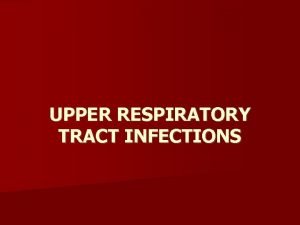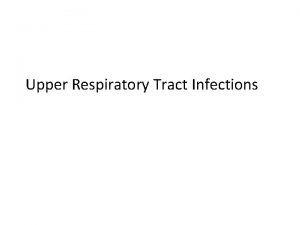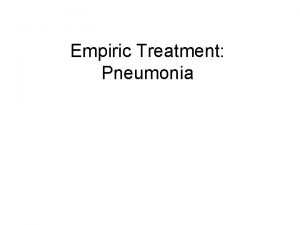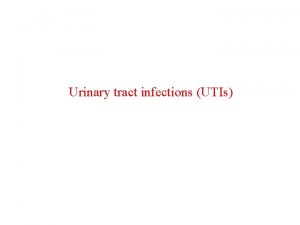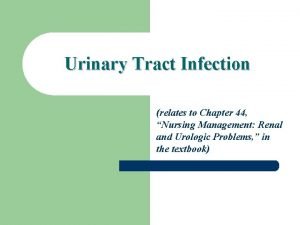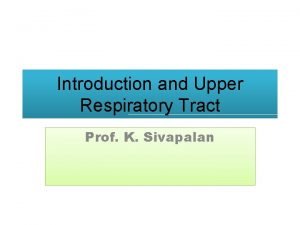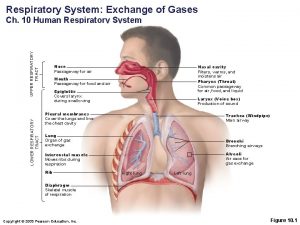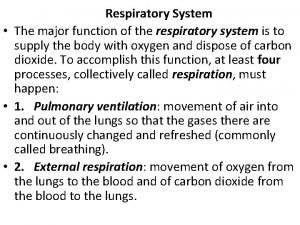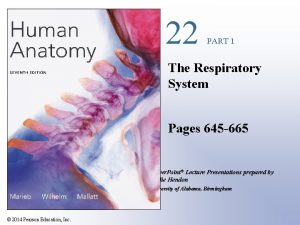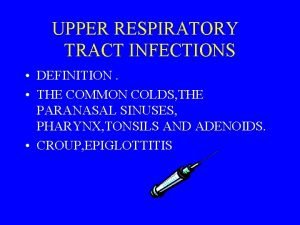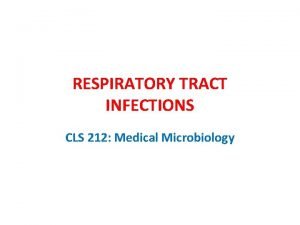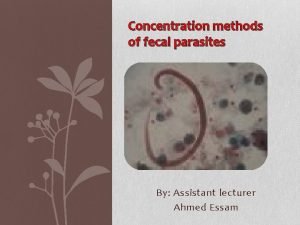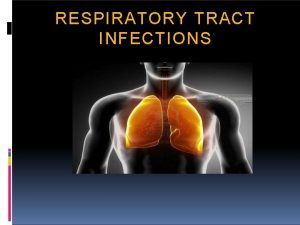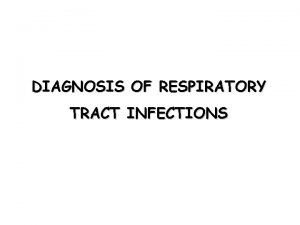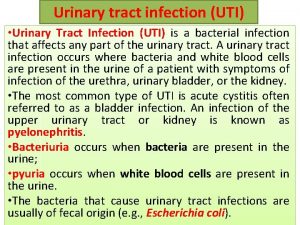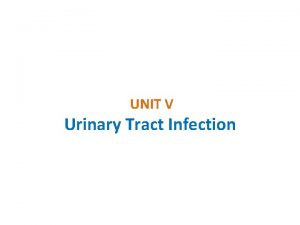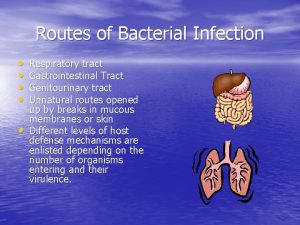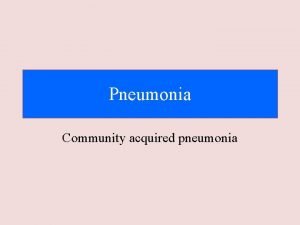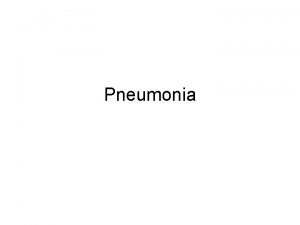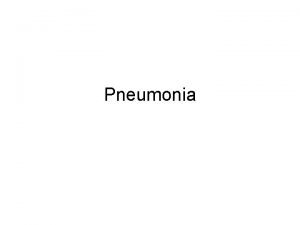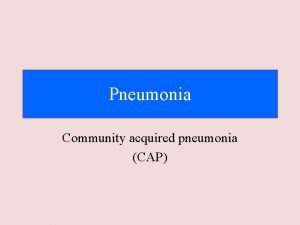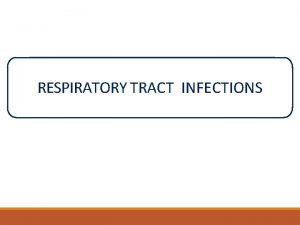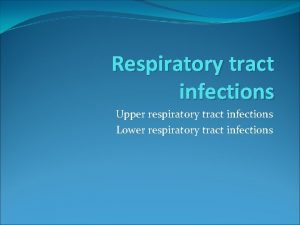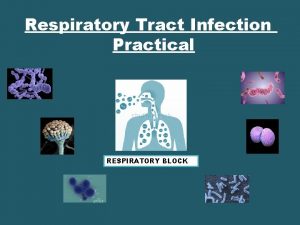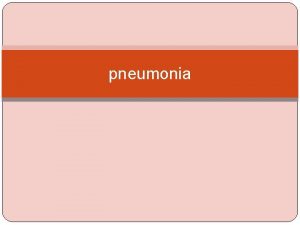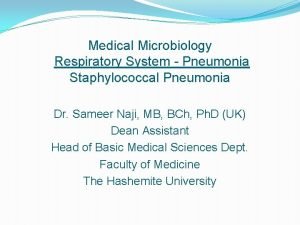RESPIRATORY TRACT PARASITIC INFECTION PARASITIC PNEUMONIA Teguh Wahju


































- Slides: 34

RESPIRATORY TRACT PARASITIC INFECTION (PARASITIC PNEUMONIA) Teguh Wahju Sardjono Sudjari Aswin Djoko Baskoro 2010 -2011

Learning Objectives After getting this lecture, student has ability to : - Describe the kind, biology and life cycle of parasites which infect respiratory tract - Explain the pathogenesis, clinical manifestation, treatment, prevention and rehabilitation of pulmonary diseases caused by parasites

Introduction The Anatomy of Lung

Parasitic Pneumonia • Definition – Parasitic pneumonia is an infection of the lungs by parasites. It is a rare cause of pneumonia, occurring almost exclusively in immuno-compromised persons. – This is a respiratory infection that may or may not be serious. • Classification ( topics which will be discussed right here) – Helminthic Pneumonia (egg, larval and adult stage) Nematodes Loeffler Syndrome Occult Filariasis Cestodes (Hydatid cyst). Trematodes (Bronchopulmonary bilharziasis i. e. Schistosomiasis, paragonimiasis). • - Protozoal Pneumonia – Amoebic Lung Absces – Pneumocystic Pneumonia – Toxoplasmic Pneumonia

Helminthic Pneumonia 1. Nematodes : Larvae Loeffler’s syndrome Occult filariasis 2. Cestodes : Hydatid cyst 3. Trematodes : rare cases Egg : Schistosoma/ Bilharziasis Pathogenesis : Verminous pneumonitis i. e. focal pneumonia caused by the worms of bilharziasis when reaching the lungs. Bilharzial granuloma or bilharzial tubercles that represent a distinctive reaction around the ovum after it penetrates the vessel wall Adult : Paragonimiasis

Loeffler’s Syndrome (Löffler's syndrome) Is a disease in which a certain type of white blood cell (eosinophil) accumulates in the lung in response to a parasitic infection. It was first described in 1932 by Wilhelm Löffler in cases of eosinophilic pneumonia caused by the parasites Ascaris lumbricoides, Strongyloides stercoralis Hookworms : Ancylostoma duodenale and Necator americanus. Many authors give the term "Löffler's syndrome" to any form of acute onset pulmonary eosinophilia no matter what the underlying cause.

Ascaris lumbricoides Ø Ø Ø common name : “human round worm” the largest of the intestinal nematodes parasitizing humans. worldwide in distribution most prevalent through out the tropics, sub-tropics more prevalent in the countryside than in the city Infection initiated by swalowing infective stage of eggs hatch in the intestine blood stream lung migration pathologic effects


Hookworms There are 2 species that infect human : 1. Ancylostoma duodenale 2. Necator americanus Adult stage parasitizes intestinal tract produce eggs Eggs hatched on the soil to be rhabditiform filariform larva Larvae penetrate the skin blood stream migrates through lungs (lung migration) pathologic effects

Strongyloides stercoralis Adult: Parasitizes intestinal tract produces eggs, hatched to be larvae Larvae : Penetrates skin Migrates through lungs Asymptomatic - most Acute infection Migrating larvae in lungs (Loeffler’s) Migration through intestinal tract abdominal pain and diarrhea Heavy infection malabsorption, steatorrhea, weight loss and edema Eosinophilia - not constant finding

The blood-lung migration phase of the larvae Löffler's syndrome During the migration through the lungs - the larvae may cause a pneumonia. - The symptoms/Clinical manifestation of the pneumonia are: - low fever, - cough, - blood-tinged sputum, - asthma. - Large numbers of worms may give rise to allergic symptoms. - Eosinophilia is generally present. .

Occult Filariasis is commonly used to designate filarial infections in which microfilaria (mf) are not found in the peripheral blood although they may be seen in tissues. However, it has now been shown that in some cases with occult filariasis, mf may actually be found after more careful blood examination despite their low density. Occult filariasis is believed to result from a hypersensitivity reaction to filarial antigens derived from microfilariae. Only a very small proportion of individuals in a community where filariasis is endemic develop occult forms of the disease. Caused by the larvae of : - Wuchereria bancrofti - Brugia malayi - Brugia timori

The clinical manifestations of Occult filariasis Tropical Pulmonary Eosinophilia (TPE) Glomerulopathies (Granulonephritis) Endomyocardial fibrosis Filarial Arthritis Filarial granulomas in the breast

Tropical Pulmonary Eosinophilia(TPE) was first described by Frimodty Moller and Barton in 1940. Its main clinical symptoms are: Severe Cough and wheezing (specially at night) Frequent weight loss and fatigue but with minimal or no fever. Restrictive or obstructive lung abnormalities. Abnormal chest radiographs that frequently show diffuse mottled pulmonary interstitial infiltrate. Peripheral blood eosinophilia > 3000 cell/µl Extreme elevation of immunoglobin (Ig. E) Extreme elevation of anti-filarial antibodies caused by an immune hyperresponsiveness to microfilariae trapped in the lungs typically seen in young males.

Tropical Pulmonary Eosinophilia (TPE) Detection: Using IFAT(Indirect Flourescent Antibody Test) filarial antibodies are detected. Treatment: Dramatic clinical improvement in response to specific anti-filarial chemotherapy with DEC

GLOMERULOPATHIES (GLOMERULONEPHRITIS) Glomerulonephritis is associated with lymphatic filariasis. Filarial antibodies have been detected in 2 of 5 children with filariasis and acute glomerulonephritis. Renal biopsy showed diffuse messangial proliferative glomerulonephritis with C 3 deposition on the basement membrane. The condition responds well to DEC therapy.

Filarial granulomas in the breast • particularly prevalent in India and Srilanka where W. bancrofti is the predominant species. • Filarial granulomas present as hard breast lumps attached to the overlying skin • difficult to distinguish from malignant tumours. • Histological examination an eosinophilic granulomatous reation around the filarial parasites which are in varying stages of degeneration. • Both adult worms and mf have been found in the granulomas. • Filarial antibodies have been demonstrated in these patients and the condition responds to DEC therapy which, in many instances, can lead to complete disappearance of the lump.

Pulmonary Hydatid cyst Hydatid disease is a parasitic infestation by a tapeworm of the genus Echinococcus Human echinococcosis is a zoonotic infection caused by the tapeworm of the genus Echinococcus. Of the 4 known species of Echinococcus, 3 are of medical importance in humans: Echinococcus granulosus, causing cystic echinococcosis (CE); Echinococcus multilocularis, causing alveolar echinococcosis (AE); Echinococcus vogeli. E granulosus is the most common of the three. E multilocularis is rare but is the most virulent Pulmonary hydatid diseases are less prevalent rather than hepatic hydatid disease

Life cycle and pathogenesis Definitive host: dogs and other canidae adult worm = Echinococcosis Intermediate host : (sheep, goat, swine and also human) got infection by ingestion of embryonated eggs larvae invade and live inside several organs eg. Liver (the most prevalent) lung, brain heart etc)

Hydatid cyst Clinical picture of the ruptured cyst: 30% of pulmonary cysts rupture, especially those with a diameter greater than 7 cm. Rupture may occur spontaneously or as a result of coughing, sneezing, muscular effort, trauma to the chest or infection. A communication with the bronchial tree allows air to leak into the potential space between the pericyst and the laminar layer. The air localizes at the superior aspect of the cyst, giving rise to the meniscus radiological sign (air cap or operculum) i. e. halo appearance. Rupture of a cyst produces an abrupt cough with expectoration and fever; hemoptysis is common.

Diagnosis: A high index of suspicion is invaluable, rural residence and contact with dogs are suggestive. Diagnosis is established radiologically and serologically. The complement fixation test (Casoni test). It is positive in 66% cases. The indirect hemagglutinin test. It is positive in about 70% of cases. Treatment : Surgical excision is the best.

Radiological Diagnosis A round partially filled cystic opacity of >8 cm diameter in right lower zone. A 5 × 6 cm circular lesion located in the apex of the right lung at X-ray. A case with bilateral hydatid cysts at lower zone of thorax. Microscopic features of hydatid cyst.

C. Adult form : Paragonimiasis caused by Paragonimus westermani Geographic Distribution: Mostly in Far East, some species also found in Southeast Asia (Thailand, Cambodya etc) Habitat of adult worm Can migrate to other organ esp brain and striataed muscle Infection in human may as long as 20 years. Cat, dog and pig can be the host

Clinical symptoms Acute phase (invasion and migration): Pulmonary disturbance, diare, abdominal pain, fever, cough, urticaria, hepatosplenomegaly. Chronic phase, lung symptoms eg cough, hemoptisis (bloody cough) abnormal radiological appearance Lesion in other organs more severe (eg : brain) Laboratory Diagnosis By finding the eggs in stool or sputum examination (2 -3 months after infection) Treatment - Praziquantel (drug of choice). - Bithionol Oval shape, brown colour, (85 µm x 53 µm) with operculum On one side and thickening of the wall At the opposite of the operculum

Broncho-Pulmonary Bilharziasis (Schistosomiasis) This includes: Verminous pneumonitis i. e. focal pneumonia caused by the worms of bilharziasis when reaching the lungs. Bilharzial granuloma or bilharzial tubercles that represent a distinctive reaction around the ovum after it penetrates the vessel wall. Pleural effusion is reported secondary to hypoproteinemia or after administration of anti-bilharzial treatment. Demonstration of bilharzial ova in the sputum was also reported. Bronchospasm simulating an asthmatic attack can also occur early in the course of the disease or during anti-bilharzial treatment. Hemoptysis can occur during the larva through the lung. Interstitial fibrosis can also occur. Transient pulmonary infiltration with oesinophils.

Diagnosis Adults of Schistosoma spp. in lung tissue, stained with H&E. Images courtesy of Harvard Medical School, Cambridge, MA

Pulmonary amebiasis The protozoa causing human amebiasis, Entamoeba histolytica, is not primarily a respiratory tract parasite. However, pleuropulmonary involvement may arise as a complication of amebic intestinal or extraintestinal disease. infection of the lung by amebae; usually indicates extension of Entamoeba histolytica infection from abscess of liver, penetrating through the diaphragm into the lung. Type of extra intestinal Amoebiasis

Pulmonary amebiasis Amebic pulmonary disease can develop in several ways Rupture of an amebic hepatic abscess through the diaphragm, which is the most common Lymphatic spread from the liver through the diaphragm Hematogenous embolic spread from the liver or colon, an unusual disorder that should be suspected when there is pulmonary amebiasis without hepatic disease or noncontiguous pulmonary and hepatic disease Fever, enlarged tender liver, weight loss, pain in the lower chest and shoulder may be found. Leucocytosis, mild anemia and raised sedimentation rate are also present.

Pleuropulmonary amebiasis is a very rare complication of amebiasis infection Direct pulmonary involvement is exceptional. The clinical diagnosis is difficult without any intestinal or extraintestinal manifestations. Extension of infection through the diaphragm may result in fibrinosis pleurisy, pleural effusion or basal pneumonia. Radiologically, there may be elevation of the right hemidiaphragm or obliteration of the costo-phrenic angle by pleural effusion.

Medical Treatment Antibiotics in lung abscess Anaerobic organisms: Gram-negative organisms First choices - Cephalosporins, aminoglycosides, quinolones Alternatives - Penicillins and cephalexin (Biocef) Oral therapy - Trimethoprim/sulfamethoxazole (Septra) Pseudomonal organisms: First choice - Clindamycin (Cleocin 3) Alternative - Penicillin Oral therapy - Clindamycin, metronidazole (Flagyl), amoxicillin (Amoxil) First choices include aminoglycosides, quinolones, and cephalosporin. Gram-positive organisms First choices - Oxacillin (Bactocill), clindamycin, cephalexin, nafcillin (Nafcil), and amoxicillin Alternatives - Cefuroxime (Ceftin) and clindamycin Oral therapy - Vancomycin (Lyphocin)

Synthetic Emetine Dehydroemetine, a synthetic product, introduced into therapeutics in 1961, replaces Emetine : six times more active than Emetine, half as toxic and of being eliminated twice as rapidly. Some time later, it is produced in the form of sugar-coated pills, which simplifies its administration. The derivatives of nitroimidazole Metronidazole, had been used since 1966 revolutionizes the treatment of all forms of Amoebiasis and leads gradually to the disappearance of all the other medicines. It is easily administered, well-tolerated and effective on the vegetative forms and cysts. This medicine is a complete amebicide. Surgery : irigation abscess fluid using water sealed drainage (WSD)

Pulmonary toxoplasmosis Toxoplasmosis is an infection due to the parasite Toxoplasma gondii. The disease can affect the brain, lung, heart, eyes, or liver, but most primary infections produce no symptoms. The time between exposure to the infection and symptom development is 1 - 2 weeks. Pulmonary Toxoplasmosis should be considered in patients with HIV receiving Aerosolized Pentamidine, who have fever and pulmonary disease but do not respond to IV Pentamidine, especially if CPK, LDH and Ig. G to T. gondii are elevated. The diagnosis of Pulmonary Toxoplasmosis in HIV disease may be delayed or overlooked, leading to death from a treatable infection. Medications to treat the infection include an antimalarial drug and antibiotics. AIDS patients should continue treatment for as long as their immune system is weak to prevent the disease from reactivating.

Pneumocystis Carinii This organism appears as minute oval bodies or cysts 5 -10 mm in length and is probably related to the protozoa. It causes pneumonia in infants of a few months of age and in adults who are immunosuppressed. Breathlessness and tachypnea are the main features, other physical signs are rarely helpful. Gas exchange becomes progressively impaired with progressive fall in the transfer factor and ultimately cyanosis. The X-ray shows widespread mottling which is slowly progressive. The diagnosis may be confirmed by lung biopsy (usually transbronchial biopsy) or broncho-alveolar lavage.

Thankyou
 Classification of upper respiratory tract infection
Classification of upper respiratory tract infection Conclusion of respiratory tract infection
Conclusion of respiratory tract infection Rute
Rute Renal lobe and lobule
Renal lobe and lobule Complicated urinary tract infection
Complicated urinary tract infection Sexually transmitted diseases
Sexually transmitted diseases Urinary tract infection in pregnancy ppt
Urinary tract infection in pregnancy ppt Urised otc
Urised otc Urinary tract infection
Urinary tract infection Pyramidal vs extrapyramidal lesions
Pyramidal vs extrapyramidal lesions Rubrospinal tract
Rubrospinal tract Hris murni teguh
Hris murni teguh Punggur rebah belatuk menumpang mati
Punggur rebah belatuk menumpang mati 7 asmaul husna
7 asmaul husna Not angka ku berbahagia
Not angka ku berbahagia Broncheols
Broncheols Upper respiratory tract
Upper respiratory tract Upper and lower respiratory system
Upper and lower respiratory system What is the major function of the respiratory system
What is the major function of the respiratory system Anatomy of upper respiratory tract
Anatomy of upper respiratory tract Anatomy of the upper respiratory tract
Anatomy of the upper respiratory tract Carina nasal
Carina nasal Trachea and windpipe
Trachea and windpipe Ethmoditis
Ethmoditis Normal flora of respiratory tract
Normal flora of respiratory tract Pneumonia classification
Pneumonia classification What is the conducting zone of the respiratory system
What is the conducting zone of the respiratory system Is fungi plural
Is fungi plural Ova cysts and parasites
Ova cysts and parasites Parasitic computing
Parasitic computing Parasitic fungi
Parasitic fungi Parasitic heterotrophs
Parasitic heterotrophs Parasitic plants
Parasitic plants Function of apophysis in rhizopus
Function of apophysis in rhizopus G h patel college of engineering and technology
G h patel college of engineering and technology
